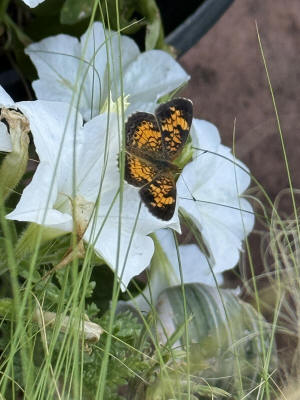|

Reduce Maintenance and Boost Your Garden Enjoyment
By Melinda Myers
[July 19, 2025]
Every
gardener has personal reasons for gardening whether it be the hope
that their garden brings joy, productivity, beauty, or peace
throughout the growing season. Embrace what makes you happy as you
tend, view, and enjoy every aspect of your garden.
Weather, busy schedules, and life in general can interfere with the
best laid plans for any garden and landscape. Take some time now to
evaluate what is working so you can do more of that and decide what
needs changing in your garden plantings, designs, and maintenance.
If you are feeling overwhelmed with the maintenance but still want
seasonal interest, consider filling garden beds with shrubs. Look
for low maintenance varieties suited to your growing conditions and
climate. Select those with multiple seasons of beauty from flowers,
foliage, fall color, and interesting form and bark. Include some
that provide birds with food, shelter, and protection from
predators. You’ll appreciate the beauty and motion these winged
visitors provide. |
|
Consider using fewer species of low-maintenance
perennials and more of each. You’ll have fewer plants to try to
identify as the garden comes to life in spring and as you weed
throughout the growing season. Look for those that are disease and
insect-pest resistant, need minimal or no deadheading and pruning,
and attract and support pollinators as well as provide winter
interest and food for songbirds in the winter.
Then add season-long color with pockets or containers of annuals.
With fewer to buy and maintain you may decide your schedule and
budget will allow you to change them out as the seasons change.
Accept and embrace the beauty of a less-than-perfect garden. Most
visitors won’t notice the imperfections unless you point them out.
Plus, faded flowers and seed pods can provide unique texture and
food for songbirds.
Do minimal cleanup that is better for the plants, pollinators and
songbirds. Do remove or cut back diseased and insect-infested plant
material as needed. Leave fall leaves in the garden to serve as
mulch, a home for some beneficial insects, and insulation for toads,
queen bumblebees, and others that overwinter underground. Allow
perennials to stand for winter, increasing hardiness, providing
homes for beneficial insects, food for songbirds, and adding winter
interest. Leave some of these stems standing throughout the upcoming
growing season to serve as homes for some of the native bees.

[to top of second column] |

Ask for or hire help if needed. As much as you love
gardening, securing help for some of the larger tasks or those that
just aren’t getting done can help boost your enjoyment. It can be
hard to find gardening help so you may need to get creative.
Consider sharing your gardening space with someone who loves to
garden but lacks a garden. Barter your knowledge and skills for help
in your garden. Or plan a round robin of fun and gardening with a
few friends. Take turns visiting and tending each other’s gardens.
You’ll enjoy the time spent together in each other’s gardens as you
tackle a gardening task or two. Then top off the visit with a
favorite beverage and snack or meal.
Don’t let your list of unaccomplished tasks or weeds stop you from
enjoying your garden and what you have accomplished. Relish every
bloom, fresh tomato, or visiting bird or butterfly.
Melinda Myers has written more than 20 gardening books,
including the Midwest Gardener’s Handbook, 2nd Edition and Small
Space Gardening. She hosts The Great Courses “How to Grow Anything”
instant video and DVD series and the nationally syndicated Melinda’s
Garden Moment TV & radio program. Myers is a columnist and
contributing editor for Birds & Blooms magazine and was commissioned
by Summit for her expertise to write this article. Myers’ website is www.MelindaMyers.com.
[Photo courtesy of MelindaMyers.com]
|